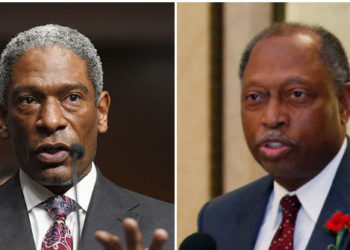This weekend, the Trump administration is planning a major military parade in Washington, D.C. The event is ostensibly designed to celebrate the 250th anniversary of the founding of the U.S. Army, although it also happens to coincide with President Donald Trump’s 79th birthday. And the parade is coming at a time when the country is experiencing significant unrest, with the U.S. government sending the military to confront protesters in Los Angeles who oppose the administration’s deportation policies.
What sort of infrastructure challenge is posed by military parades? What is the military purpose of parades? And how do parades contribute to forging national unity?
Those are just a few of the questions that came up in my recent conversation with FP economics columnist Adam Tooze on the podcast we co-host, Ones and Tooze. What follows is an excerpt, edited for length and clarity. For the full conversation, look for Ones and Tooze wherever you get your podcasts. And check out Adam’s Substack newsletter.
Cameron Abadi: The cost of Trump’s parade is estimated to be around $45 million, with a significant portion of that set aside for repairs after the parade. What kind of infrastructure challenge exactly is being posed by this kind of parade in Washington, D.C.?
Adam Tooze: Yeah, it’s extraordinary. I mean, Trump apparently has ordered for his birthday a parade of 150 vehicles, including heavy Abrams tanks, 50 helicopters, 6,600 troops participating. The last time that Washington, D.C., saw anything like this was in 1991, after the [George H.W.] Bush administration had expelled [Iraqi leader] Saddam [Hussein] from Kuwait. And they actually came back from a war—a short war, admittedly—and one that was very one-sided, but nevertheless, an actual war. This is just a shindig for the president’s birthday and the anniversary of the American military. Moving this kind of military hardware is a big logistical task. If you follow MAGA Twitter, you’ll be able to see people gleefully commenting on the arrival of large barges of heavy military equipment in D.C. and offering their services to help go repress the “woke mob” and crush antifa. So, it’s raising everyone’s blood.
The issue is, though, that driving large, heavy tanks through urban areas comes at a price. And the last time America did it in 1991, it was generally judged to have been a little bit of a shambles in the aftermath. And it’s with good reason that there haven’t been any displays since. So tanks are sometimes shown in D.C., but they generally are transported on trailers and then displayed in a stationary way. Because the real problem with tanks is when they move. And you might think it’s because of their weight, because they weigh somewhere between 60 and 80 tons, depending on the model that you’re talking about. But in fact, that isn’t the problem. Because the thing about tanks is they have tracks, and the tracks spread the weight of the tank over a large area, which is part of what enables them on a good day to survive in muddy terrain. If you think about the size of a large truck, that’s also in the 20-ton scale for a really, really big one, and their surface area is relatively smaller because it goes through just the print of a tire. And so, actually, tanks have, per inch of tarmac that they travel over, the pressure is not greater than an SUV.
The problem is that the tracks are metal and the tanks maneuver by basically accelerating one side of their tracks against the other side and they claw their way over the road surface. And it’s that crab-like clawing action of the tank tracks that tears into the road surface. And especially on a hot day, and it could easily be hot in June in D.C., with the road’s surface being softened by the heat, basically they just churn it up and eat their way through. And that’s the problem. There’s also issues with bridges. America’s bridges are in a notoriously disrepaired state. But apparently the Army teams think that if only one tank crosses all of the relevant bridges at a time and keeps on going at a gentle speed without causing too much vibration, all should be well. But fingers crossed. It could easily end up in a shambles.
CA: From a military perspective, what has the purpose of these parades been? Are they a matter of displaying personnel and their discipline in public fashion? Or has it traditionally been more a matter of showing off hardware to deter adversaries? Or is it militaries displaying their prowess as leverage for continued funding domestically?
AT: The origin of this is very deep. It’s quite surprising. Well before there are modern states, there are military parades of different types. I mean, the earliest origins are in Mesopotamia, as early as like 2900 BC. Though there, there’s an overlap, I think, between religious procession and the display of armed forces. The pharaohs in ancient Egypt had what we would recognize as military displays with weapons, captives, the whole works. And you can see those in the extraordinary Egyptian sculpture that’s left to us. The truly modern form really begins to take shape in classical antiquity. So the Hellenistic displays under Antiochus featured cavalry, infantry, chariots, elephants. And they were really quite clearly a political demonstration of power.
And they reached their really classical form in Rome. And there, I think, all of the different elements that you’re talking about are already quite well-developed. The word “triumph” originates in what the Romans called the triumphator, so the triumphant general who will be celebrated. The marches themselves were known as triumphs, and they displayed everything you mentioned, so captives, spoils, troops that would march under the sign toward the Temple of Jupiter. Apparently, the general was assigned a slave who would continuously whisper into his ear, “Remember you are mortal.” Apparently not a role that we should expect anyone to be performing this Saturday for Donald Trump. And there would be sporting events to go with it, circus games, youth performances, the whole works. And so I think by the Roman period, the kind of idea of the collective display of military hardware was well established effectively almost 2,000 years ago—in the European tradition, at least. And it played all of the roles that you suggested. It was about triumph over your enemies, internal politics, and also, of course, staking a claim to relevance and centrality to the polity of which you were part. And that echoes all the way down to the present day.
CA: Clearly Trump seems to have been influenced by a visit to France during Bastille Day, when there’s famously a military parade that is the centerpiece of a national holiday. But these displays can also be designed to intimidate the public rather than really forging a common sense of identity. Historically, what general cultural role have these parades played?
AT: I think one element of it is the logic of the militaries themselves. The classic image we have of the parade is of soldiers marching in lockstep in metronomic formations, almost like a gigantic Broadway show or ballet or something like that. And that comes first. So the regimental drill tradition of parade-ground activity begins with the disciplining of European armies in that mode, which is an 18th-century innovation, which becomes truly formalized on a huge scale in the late 18th and early 19th centuries. But those tend to be dynastic armies. By the Napoleonic Wars, there’s patriotism associated with them. The French Revolutionary Army, of course, has a great nimbus of patriotism. But it isn’t really until the late 19th century that we get the truly archetypal convergence of mass armies based on conscription with regimented drill being paraded to the entire public in a festive national spirit.
And it is France, I think, which probably can claim the origin of this. I mean, Germany, after the defeat of France in 1871, had big parades, but it was a monarchical structure. Whereas the French Republic, after it had gone through multiple convulsions, the Third Republic that emerges from the defeat against Prussia and then the commune and the restoration of a republican spirit in the 1880s, declares the 14th of July to be Bastille Day. Because for the monarchical regimes that came in between, celebrating the revolution was quite problematic. So it’s really in 1880 that the Bastille Day celebration that we associate with France today was first instituted. And it was a republican national holiday that was culminated in a military parade. In most of France, it doesn’t. If you’re just in the countryside in France, it’s more like the fire service might go and parade, but it won’t necessarily be the military. In Paris, it’s the military. Originally, they did this on a parade ground, as you’re referring to. But in 1918, they moved to the Champs-Élysées.
And the tradition built during the interwar period. And interestingly, during World War II, when of course, Paris was occupied by the Germans and the Germans would hold parades, which were very much in the manner of intimidation, the Free French in London would hold a small parade of French commando forces under [Gen. Charles] de Gaulle’s command in London. And then the tradition resumed in Paris after liberation in 1945. Soviet parades are interesting because they go through a similar relatively recent tradition of invention. We think of these as traditions which go back to ancient history. They really in many cases don’t—the French one to 1880.
The classic Red Square Victory Day parade which we associate with the Soviet regime now was actually only really put into place by [Soviet leader Leonid] Brezhnev in 1965. And it was emphatically part of the kind of effort to mobilize Soviet public opinion in the Cold War, to harden lines and to intimidate the Soviet Union’s external enemies. So again, not a deep tradition. I mean, there are famous parades held on the occasion, for instance, of the October Revolution, which is in November in our calendar, in Moscow during World War II as the Germans are invading. So the Soviet regime has military-style parades that are associated with the revolutionary calendar, but for the Soviet Union to organize around the military event of the defeat of Germany, that really is a tradition which doesn’t go any further back than 1965. So that really surprised me. I would have thought it would be something that would cut in immediately after the end of the war.
But perhaps unsurprisingly, given just the gigantic scale of Soviet losses, the commemoration of the aftermath of the war was rather more muted in the years that followed immediately after, when people were dealing with the true horror and scale of the loss. And it’s with a degree of safe distance that the commemoration takes on the rather stylized, state-driven pomp and ceremony that we associate with victory parades in Moscow now.
The post A Brief History of Military Parades appeared first on Foreign Policy.




